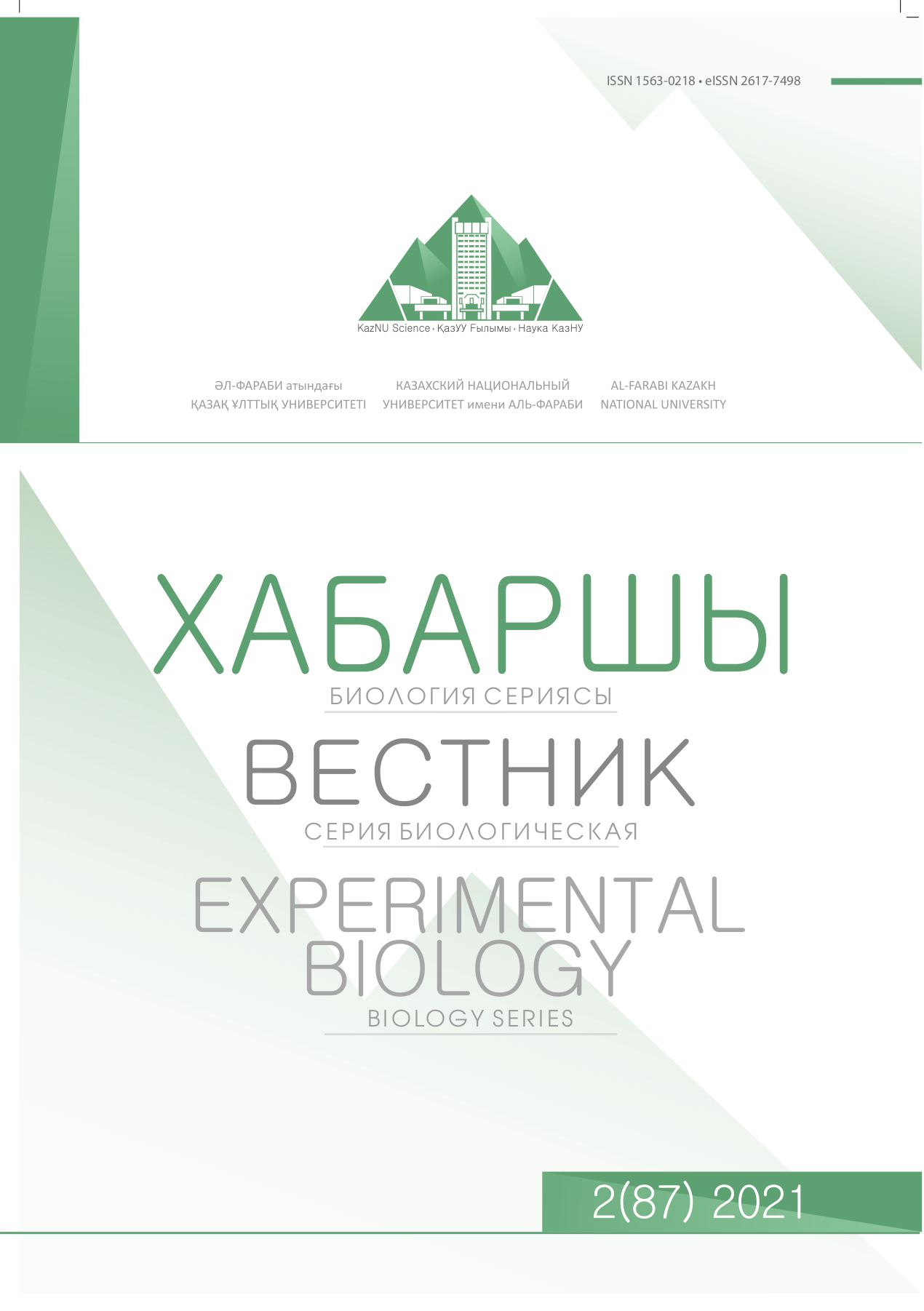INTRODUCTION AND COMPARATIVE CHARACTERISTIC OF MALUS SIEVERSII VARIETY CLONES OF THE DZHUNGARIAN POPULATION
DOI:
https://doi.org/10.26577/eb.2021.v87.i2.07Abstract
Malus sieversii is a mountain-steppe and valley tree species widespread in the mountains of southeast Kazakhstan. The aim of this work is to study the structure of variability and intraspecific differentiation of Malus sieversii (Ledeb.) M. Roem. based on a complex of morphological features of generative organs and the characteristics of the seasonal rhythm of apple trees in natural and introduction conditions. Malus sieversii is a mountain-steppe and valley tree species widespread in the mountains of southeast Kazakhstan. The introduction collection of Malus sieversii’s forms growing in the Main Botanical Garden of Almaty (GBS) is a source of global genetic resources. According to the research data, the intraspecific variability of the studied apple tree forms was characterized by heterogeneous morphometric parameters of the generative organs. The studied apple trees are distinguished by heterogeneous morphometric parameters. Large-flowered forms were observed both in natural populations and in GBS. In the conditions of the Dzungarian Alatau, the large sizes of flowers were characteristic of the forms in the gorges of Pikhtovaya and Mushabay. Among the variety clones the sample TP-19 selected in the Pikhtovaya distinguished itself by the large size of the corollas.
References
Baytulin I.O. (2008) K probleme sohranenia hozayistvenno-tsennyh redkih vidov rastenii [On the problem of conservation of economically valuable rare plant species] // Bulletin of KazNU. Biological Series. Vol. 1 (265). P. 3-8.
Andreev L.N., Gorbunov U.N. Sohranenie redkih I ischezaushih rastenii ex-situ: dostijenia I problem [Ex situ conservation of rare and endangered plants: achievements and challenges]// Izuchenie i ohrana raznoobrazia fauny, flory I osnovnyh ecosystem Evrazii. Moskva. P. 19-23
Mukanova G.S. et al. (2017). Genofond dikih plodovyh rastenii Kazakhstana [The gene pool of the wild fruit plants of Kazakhstan] // Materialy konferentsiya Mat.mezhdun.nauch. konf. “Izuchenie, sohranenie I ratsionalnoe ispolzovanie rastitelnogo mira Evrazii” Almaty, P. 548-550.
Langelfelds V. (1991) Yablonya. Morfologicheskaia evolutsia, filogenia, geografia, sistematika [Apple-trees. Morphological evolution, phylogeny, geography, systematics]. Riga, 231p. ISBN 5-7966-0379-5.
Dzhangaliev A.D. et al. (2003) The wild fruit and Nut Plant of Kazakhstan. Horticular Reviews, 371p. ISBN 0-471-21968-1.
Shadmanova L., Sitpayeva G., Mukanova G., Friesen N. (2019) Molecular-genetic analysis of Malus sieversii– comparison of Dzungarian populations in-situ and ex-situ. Turczaninowia. 22 (2). DOI: 10.14258 / turczaninowia. 22.2.0
Dzhangaliev A.D. (1969) Yablonevie lesa Zailiiskogo I Djungarskogo Alatau, ih sohranenie I ispolzovanie [Apple forest of Zailiyskei and Dzhungaskei Alatau, its preservation and use]. Bot. Inst. Acad. Sci. USSR, PhD Diss., Leningrad, P.118.
Zhang H., Zhang M., Wang L. (2015) Genetic structure and historical demography of Malus sieversii in the Yili Valley and the western mountains of the Junggar Basin, Xinjiang, China. J Arid Land. 7(2): 264–271. DOI: 10.1007/s40333-014-0044-2
Isayev E. B. (2014) Malus sieversii (Ledeb.) M. Roem. // Krasnaya Kniga Kazakhstana [Malus sieversii (Ledeb.) M. Roem. In: Red Data Book of Kazakhstan] Vol. 2. Part 1. Plants. Ed. by I. O. Baitulin. Almaty, 52 p.
Danilov M. P., Sitpayeva G. T. et al. (2018) Sibirskie vliyania v rastitelnom pokrove Сибирские влияния в растительном покрове Dzhungaskogo Alatau [Siberian influences in vegetative cover of Dzungarian Alatau] // Mat. XVIII mezhdun. nauch.-pract. konf. «Problemy botaniki Iuzhnoi Sibiri I Mongolii». Barnaul, P. 246-250.
Kerdyashkin A. V., Shadmanova L. Sh. et al. (2019) Sovremennoe sostoyanie yablonevyh soobshestv severnogo hrebta Zhetysuskogo Alatau [The current state of apple communities in the Zhetusu Alatau northern ridge] // Mat. XVIII mezhdun. nauch.-pract. konf. «Problemy botaniki Iuzhnoi Sibiri I Mongolii». Barnaul, P. 276-283.
Zhou Z. Q., Y.N. Li. (2000) The RAPD evidence for the phylogenetic relationship of the closely related species of cultivated apple. Genet Res Crop Evol. 47:353–357. DOI: 10.1023/A:1008740819941
Forsline P. L., Aldwinckle H. S., Dickson E. E., Hokanson S. C. (2003). Collection, maintenance, haracterization, and utilization of wild apples from central Asia. Hort. Rev. 29:1–61.
Programma I metodika sortoizuchenia plodovyh, yagodnyh I orehoplodnyh kultur (1973) / pod red. Lobanova G. A. Michurinsk. 380 p.
Dospehov B.A. (1979). Field experiment technique [Metodika polevogo opyta]. M.: Kolos. P. 262-289.
Leonova, N.V. Problems of Horticulture Development these Days. Economy and Entrepreneurship, 2017, no. 9-1 (86–1), pp. 949-952.
Topics in Biostatistics (2007) / edited by Walter T. Ambrosius. – New Jersey: Humana Press inc., 530 p.
Lakin G.F. (1973). Biomertriya [Biometrium]. Moscow, 338 С.
Zaitsev G. N. (1973). Metodica biometricheskih raschetov [Biometric calculation method]. Moskva: Nauka., P. 251.
Korosov A.V., Gorbach V.V. (2010). Komputernaya obrabotka biologicheskih dannyh: metod. posobie [Computer processing of biological data: method allowance]. Petrozavodsk: PetrSU Publishing House, 84 p.
Biyasheva Z. M., Lovinskaya A. V., Dauletbaeva S. B., Kalimagambetov A. M. (2019) Statisticheskie metody v biologii s programnym obespecheniem. Uchebnoe posobie [Statistical methods in biology with software. Tutorial]. Almaty: Kazakh Univer., 107 p.
Zapryagaeva V. I. (1964) Dikorastusshie plodovye Tadjikistana [Wild fruits of Tajikistan]. Moscow, 695 p.
Serebryakov I. G. (1962). Ekologicheskaya morfologiya rastenii [Ecological morphology of plants]. Moscow, 378 p.
Bulygin N.E. (1976). Dendrologia. Fenologicheskie nabludenia nad listvennymi drevesnymi rasteniyami [Dendrology. Phenological observations on deciduous woody plants]. Leningrad, 70 p.
Grimshaw J., Bayton R.New Trees: Recent Introductions to Cultivation. Kew: Kew Publishing, 2009. – 976 p.




